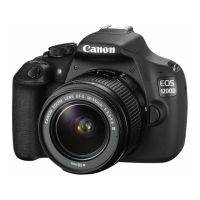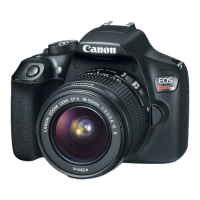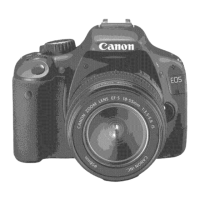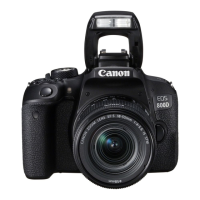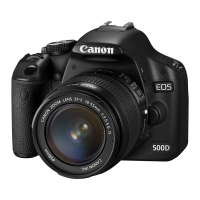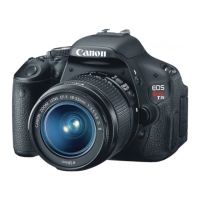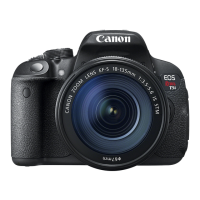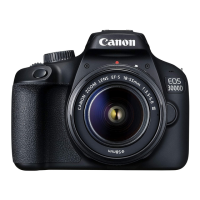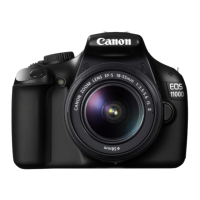Do you have a question about the Canon EOS REBEL T7 and is the answer not in the manual?
Essential safety and handling instructions for safe camera operation and accident prevention.
Procedure to verify camera functionality and understanding Canon's liability limitations for faulty equipment.
Guidelines for maintaining the camera, including avoiding drops, water, heat, and proper cleaning.
Advice on battery charging, usage in foreign countries, and recognizing battery end-of-life.
Detailed steps for inserting the battery and memory card into the camera, and closing the cover.
Procedures for safely removing the battery and memory card from the camera.
Explanation of the battery level icons displayed on the screen and their meaning.
Steps for correctly attaching a Canon EF or EF-S lens to the camera, including aligning mount indexes.
Techniques for holding the camera steady to minimize camera shake for sharper images.
Explanation of the two-step shutter button function: pressing halfway for autofocus and completely to take the picture.
Tips to avoid camera shake, including proper holding techniques and slow shutter presses.
Step-by-step guide on navigating menus, selecting tabs, items, and settings.
Guidance on when to use low-level formatting for SD cards and its implications.
Explanation of how Auto Lighting Optimizer adjusts brightness and contrast for optimum image quality.
Using AI Servo AF in automatic mode to continuously focus on moving subjects.
How to select and shoot with desired ambiances for creative image expression.
Adjusting background blur for portraiture or landscape shots using the Creative Auto mode.
Descriptions of various ambience settings like Standard, Vivid, Soft, Warm, Intense, Cool, Brighter, Darker, and Monochrome.
How to use index display (4 or 9 images) to quickly find and select images.
Switching between 4-image and 9-image index displays for faster image browsing.
How to jump through images forward or backward based on selected methods like date or folder.
How to magnify captured images for detailed inspection and precise focus checking.
How to rotate displayed images to the desired orientation for proper viewing.
How to assign rating marks (1-5) to images for organization and quick access.
Using Quick Control during playback to apply functions like image protection, rotation, rating, and filters.
Table detailing image quality settings, pixel counts, file sizes, and possible shots.
Information on using Digital Photo Professional (DPP) for processing RAW image files.
Guide to ISO speeds and their corresponding shooting situations and flash ranges.
How to set the maximum ISO speed limit when using ISO Auto mode.
Descriptions of various Picture Styles like Auto, Standard, Portrait, and Landscape.
Explanation of One-Shot AF for focusing on stationary subjects and how focus is achieved.
Guidance on using AI Servo AF for continuously focusing on moving subjects.
How AI Focus AF automatically switches between One-Shot and AI Servo AF.
Instructions on how to use manual focus for precise focusing when autofocus fails.
How to enable and use the red-eye reduction feature to minimize red eyes in flash photos.
How to enable and use the depth-of-field preview function to check focus range before shooting.
Explanation of bulb exposure for long exposures and its usage with fireworks.
Tips for using AEB with continuous shooting, self-timer, and its limitations with flash or bulb exposures.
Table explaining AE lock application based on metering mode and AF point selection method.
Information on the camera's built-in lens peripheral illumination correction data and how to manage it.
Detailed explanation of how to adjust Sharpness, Contrast, Saturation, and Color tone.
How to use Auto White Balance (Ambience/White priority) for color tone adjustment.
Procedure for manually setting white balance using a white reference object.
How to adjust white balance by shifting the color balance towards blue, amber, magenta, or green.
How to record three images simultaneously with different white balance tones (blue/amber or magenta/green bias).
How to shoot remotely using EOS Utility software connected to a computer.
Steps to enable Live View shooting and information on possible shots and shooting time.
How to set shooting functions like AF method, white balance, and ISO speed during movie shooting.
Explanation of menu options available specifically for Live View shooting.
Overview of available AF methods for Live View shooting: FlexiZone, Live Mode, and Quick Mode.
How Face Detection works within Live View mode for automatic focusing on human faces.
List of scenarios and subjects that commonly cause autofocusing problems.
Steps to shoot movies using automatic exposure settings, including focusing and starting/stopping recording.
How to manually set shutter speed, aperture, and ISO for movie shooting for advanced control.
Explanation of the various shooting information displays available during movie recording.
Important cautions regarding movie shooting, including skin contact, light sources, AF behavior, and lens sounds.
How Picture Style, white balance, and other settings affect the movie's appearance before recording.
Steps to shoot and save video snapshots as an album, and continue adding to it.
Important notes and restrictions regarding video snapshot duration, album creation, and firmware updates.
How to freely create and select folders for saving captured images on the memory card.
Explanation of file numbering sequences (Continuous, Auto reset, Manual reset) and their behavior.
How to append copyright information (author name, details) to images as Exif data.
Steps to erase individual images from the camera and the consequences of erasure.
How to select multiple images with checkmarks for batch erasure.
How to erase all images in a folder or on the card, including formatting the card to erase protected images.
Information on direct printing via PictBridge and wireless LAN printing.
How DPOF enables setting print instructions like image selection and quantity for batch printing.
How to select images for photobook printing and transfer them to a computer folder.
How to crop an image to print an enlarged portion, recomposing the shot before printing.
How to select individual images for photobook printing and transfer them to a computer folder.
How to specify all images in a folder or on the card for photobook printing at once.
How to enable automatic or manual noise reduction for long exposures.
How to reduce noise generated at high ISO speeds and its effects on burst shooting.
How to improve highlight detail and dynamic range, affecting ISO and Auto Lighting Optimizer settings.
Customizing the shutter button's half-press and AE lock functions for different AF operations.
How to assign frequently used functions to the SET button for quick access.
Basic operation of EX-series Speedlites, including autoflash control by the camera.
Important cautions regarding Eye-Fi card usage, Wi-Fi/NFC conflicts, and potential overheating.
Common issues related to battery recharging, charger blinking, camera operation, and access lamp behavior.
Common shooting issues like lens attachment, image recording, focus, and focus lock.
Troubleshooting steps for issues with card insertion, write-protect switch, full cards, and focus indication.
Common causes and solutions for out-of-focus images, including lens settings and camera shake.
Causes of horizontal stripes or abnormal exposure/color tone, often related to lighting conditions.
Why images might appear bright even with decreased exposure settings, related to Auto Lighting Optimizer.
How slow shutter speeds in Av mode with flash can be prevented using Custom Functions.
Meaning of internal temperature warning icons during Live View shooting.
Meaning of internal temperature warning icon during movie shooting, indicating potential termination.
Reasons for movie shooting stopping automatically, including slow card speed and file size/time limits.
Causes of image flickering or horizontal stripes during movie shooting, and potential solutions.
Reasons for movie recording stopping momentarily due to exposure level changes.
Troubleshooting steps for connecting the camera to a TV via HDMI, including terminal checks and Wi-Fi/NFC settings.
Issues related to connecting the camera to a printer and available printing effects.
Troubleshooting steps for printer connection issues, especially related to Wi-Fi/NFC settings.
Steps for connecting the camera to a computer and downloading images using EOS software.
Troubleshooting steps for computer connection issues, particularly related to Wi-Fi/NFC settings.
Specifications for aspect ratio, focus methods, focusing brightness, metering modes, and grid display in Live View.
Specifications for recording format, audio, resolution, frame rates, bit rates, and focus/metering in movie mode.
Step-by-step guide for downloading and installing Canon software on a computer.
Methods for transferring images from the camera to a computer using EOS software.
Guide on downloading software from Canon's website and following installation instructions.
Steps to connect the camera via USB and use EOS Utility to transfer images.
How to download images using a card reader and Digital Photo Professional software.
| Megapixel | 24.1 MP |
|---|---|
| Camera type | SLR Camera Kit |
| Sensor type | CMOS |
| Sensor format | Advanced Photo System type-C (APS-C) |
| Image stabilizer | Yes |
| Total megapixels | 24.7 MP |
| Image sensor size | - \ |
| Image formats supported | RAW |
| Supported aspect ratios | 1:1, 3:2, 4:3, 16:9 |
| Maximum image resolution | 6000 x 4000 pixels |
| Image sensor size (W x H) | 22.3 x 14.9 mm |
| Still image resolution(s) | 6000 x 4000, 3984 x 2656, 2976 x 1984, 2400 x 1600, 5328 x 4000, 3552 x 2664, 2656 x 1992, 2112 x 1600, 6000 x 3368, 3984 x 2240, 2976 x 1680, 2400 x 1344, 4000 x 4000, 2656 x 2656, 1984 x 1984, 1600 x 1600 |
| Filter size | 58 mm |
| Optical zoom | - x |
| Focal length range | 18 - 55 mm |
| Maximum aperture number | 5.6 |
| Minimum aperture number | 4 |
| Lens structure (elements/groups) | 12/10 |
| Focus | TTL |
| Focus adjustment | Auto/Manual |
| Auto focusing (AF) modes | AI Focus, One Shot Focus, Single Auto Focus |
| Normal focusing range (tele) | - m |
| Light metering | Centre-weighted, Partial |
| ISO sensitivity | 100, 200, 400, 800, 1600, 3200, 6400, 12800, 25600, 51200 |
| Light exposure modes | Aperture priority AE, Auto, Manual |
| ISO sensitivity (max) | 51200 |
| ISO sensitivity (min) | 100 |
| Light exposure correction | ± 3EV (1/2EV; 1/3EV step) |
| Camera shutter type | Mechanical |
| Fastest camera shutter speed | 1/4000 s |
| Slowest camera shutter speed | 30 s |
| Flash modes | Auto, Fill-in, Pre-flash, Red-eye reduction |
| Flash exposure correction | ±2EV (1/2, 1/3 EV step) |
| Video resolutions | 640 x 480, 1280 x 720, 1920 x 1080 pixels |
| Motion JPEG frame rate | 59.94 fps |
| Maximum video resolution | 1920 x 1080 pixels |
| Memory slots | 1 |
| Compatible memory cards | SD, SDIO, SDXC |
| Display diagonal | 3 \ |
| Display resolution (numeric) | 1040000 pixels |
| Magnification | 0.8 x |
| Viewfinder type | Electronic |
| USB version | 2.0 |
| HDMI connector type | Micro |
| Scene modes | Close-up (macro), Food, Landscape (scenery), Night portrait, Portrait, Sports |
| Photo effects | Black&White, Negative film, Sepia, Vivid |
| White balance | Auto, Cloudy, Custom modes, Flash, Shade, Tungsten |
| Shooting modes | Auto, Manual, Program, Scene |
| Camera playback | Movie, Single image, Slide show |
| Self-timer delay | 2, 10 s |
| Camera file system | DPOF, Exif 2.1 |
| Product color | Black |
| Battery voltage | 7.2 V |
| Operating temperature (T-T) | 0 - 40 °C |
| Operating relative humidity (H-H) | 0 - 85 % |
| Package height | - mm |
| Package volume | - cm³ |
| Package weight | - g |
| Quantity per pack | - pc(s) |
| Depth | 77.6 mm |
|---|---|
| Width | 129 mm |
| Height | 101.3 mm |
| Weight | 427 g |
| Weight (including battery) | 485 g |
